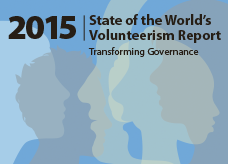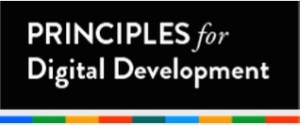 I’m thrilled with the United Nations Volunteers program’s recently published 2015 State of the World’s Volunteerism Report – Transforming Governance.
I’m thrilled with the United Nations Volunteers program’s recently published 2015 State of the World’s Volunteerism Report – Transforming Governance.
Oh, yes, you read that right. THRILLED. And , as you know, I am a tough audience.
Why am I thrilled? Because, instead of doing the usual – talking about the value of volunteers only, or mostly, in terms of money saved because they aren’t paid a salary – this report talks about the value of volunteers in the terms that are much more powerful and important, value that goes far beyond money. Excerpts from the reports introduction explain better than I can:
For the post-2015 sustainable development agenda to succeed, improving governance, tackling inequalities, and expanding voice and participation need to be addressed simultaneously. Volunteerism can help by giving voice to stakeholders and by mobilizing people and civil society organizations to contribute to solutions.
The report suggests that the ability of volunteers to support development progress depends on the willingness of national governments to ensure that the space and supportive environments which encourage their participation and initiatives are available. The Report finds that volunteerism can help to generate social trust, advance social inclusion, improve basic services, and boost human development. Volunteers and volunteerism bring the greatest benefits where enabling conditions like freedom of speech and association and an atmosphere of vigorous political debate are already in place. At the local level, the Report suggests that volunteerism can increasingly be a vehicle for people in excluded and/or marginalized communities to be heard, and to access the services, resources, and opportunities they need to improve their lives.
Examples of formal and informal volunteering attest to the fact that those who are marginalized, such as women, indigenous populations and disempowered young people, can create spaces where their voices can be heard and where they can affect governance at local levels. This report addresses the issue of women’s engagement, providing interesting examples of how women have been able to engage in spaces outside the traditional norms, hold authorities accountable and ensure responsiveness to their needs and those of their communities.
Further research and innovative strategic partnerships are needed for better understanding, documenting and measuring volunteerism and its contribution to peace and development. This report starts a conversation that can and needs to be deepened.
And this, from the executive summary:
This report shows, using a body of knowledge collected through case studies, that volunteerism provides a key channel for this engagement from the local through to the national and global contexts.
This report has identified key strategies, challenges and opportunities for volunteerism, focused on three pillars of governance – voice and participation, accountability and responsiveness – where volunteers have shown impact. Specific volunteer actions and strategies illustrate the diverse ways in which volunteers engage in invited spaces, open up closed spaces or claim new spaces.
Volunteerism spans a vast array of activities at the individual, community, national and global levels. Those activities include traditional forms of mutual aid and self-help, as well as formal service delivery. They also include enabling and promoting participation and engaging through advocacy, campaigning and/or activism. The definition of volunteerism used in this report refers to “activities … undertaken of free will, for the general public good and where monetary reward is not the principal motivating factor.”
Volunteering in this report is also understood as overlapping and converging with social activism; while it is recognized that not all activists are volunteers, many activists are volunteers and many volunteers are activists. The terms volunteerism and social activism are not mutually exclusive. The idea that volunteers only serve to support service delivery or are only involved in charitable activities is one that is limited and provides a superficial line of difference between volunteerism and activism.
The report recognizes that volunteering is highly context specific and is often not on a level playing field. Women and marginalized groups are frequently affected by this unevenness; not all volunteers can participate equally or on equal terms in each context. Volunteerism is harder in contexts where people are excluded, their voices curtailed, their autonomy undermined and the risks of raising issues high. An enabling environment that respects the rights of all enhances the ability of volunteerism to contribute to positive development and peace. The report shows that creating a more enabling environment that allows positive civic engagement in sustainable development is critical for success.
If you do nothing else, PLEASE read the report’s executive summary.
Every program or project manager in every local, regional or government office needs to read at least the executive summary: government workers that are focused on police, fire and emergency response, parks and recreation, environmental issues, agriculture, the justice system, education, public health, arts, library, historical sites, economical development – they all need to read this report, look at how they currently involve the community, and ask themselves lots of questions:
- Could you do a better job involving volunteers in decision-making?
- Could you do a better job involving a greater diversity of volunteers – women, minority groups, children, the people that are the target of government services, etc.?
- Are there tasks that volunteers actually might be better at doing than paid staff, because they wouldn’t have any worries regarding job security or loss of pay?
- Are – or could – volunteers help your organization be more transparent to the general public and improve services?
- Could volunteers help you build bridges with hostile communities?
- Have you handled critical comments from volunteers appropriately?
This report can help you start answering those questions.
For more on the subject of the value of volunteer or community engagement

 It never fails: try to have a conversation about diversity and volunteerism, get comments about how such conversations are not needed.
It never fails: try to have a conversation about diversity and volunteerism, get comments about how such conversations are not needed.
